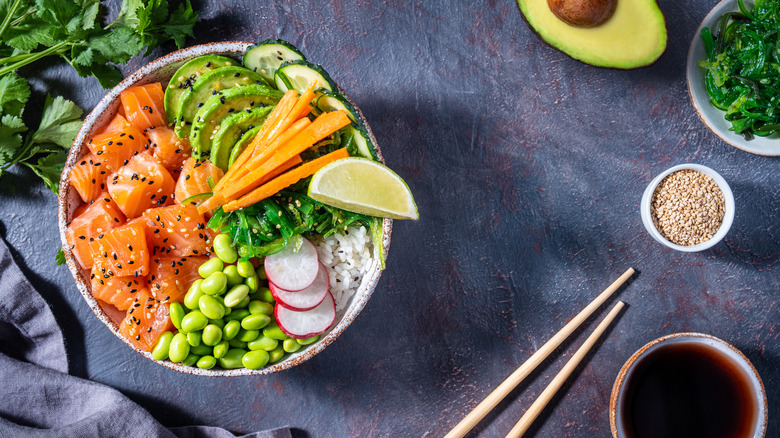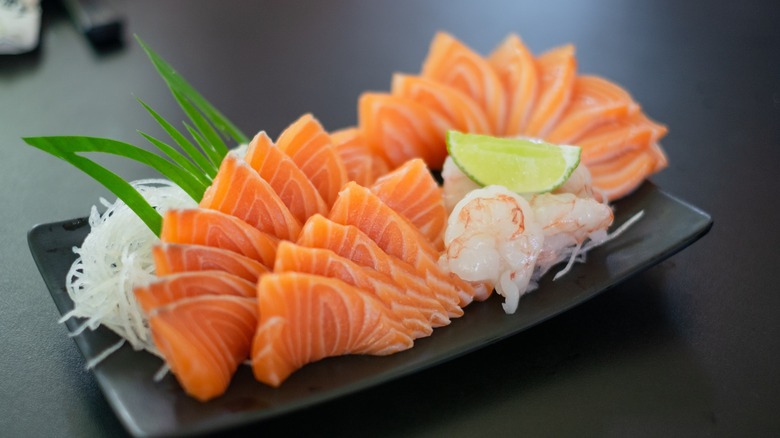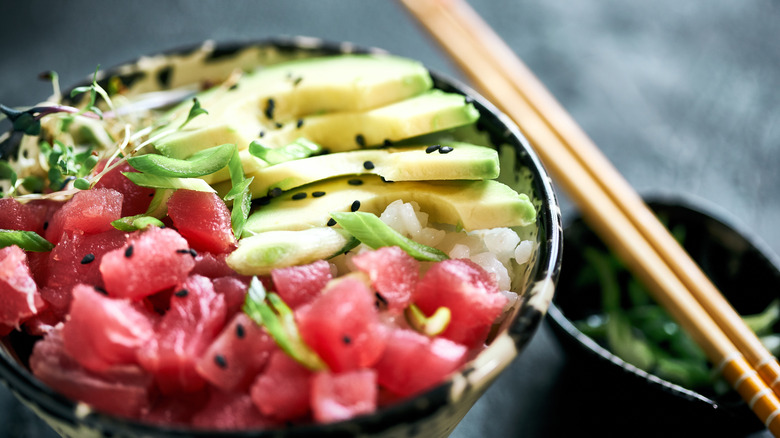Poke Vs Sashimi: What's The Difference?
Don't believe just anyone who tells you raw fish is dangerous (though it's certainly not as healthy as some might think); unlike, say, chicken, properly stored and fresh raw fish offers much less of a health risk (per the CDC in Time Magazine). There are a lot of options for modern diners when it comes to delicious raw fish dishes. And while sushi may be the most famous raw fish preparation, it isn't the only one; modern American diners can now easily get their hands on other options like sashimi and poke.
But what's the difference between the two? Are they just two names for the same thing? Not at all, actually; sashimi and poke both involve raw fish (or at least usually do), but that's where the similarities end. While sashimi consists of thinly-sliced pieces of plain fish, poke is typically seasoned, cubed raw fish. But it's not just the shape of the cut that determines the difference; each dish is radically different in ingredients and presentation. Heck, poke and sashimi aren't even from the same country.
Sashimi is for people who want straight-up raw fish
Sashimi consists of pieces of thinly-sliced fish, like tuna, salmon, eel, or octopus. The word roughly translates to "pierced meat," meaning there's no such thing as cucumber or egg sashimi. The fish slices aren't typically seasoned with a marinade or even salt — it's just straight-up plain, raw fish, which can be eaten with ginger, soy sauce, wasabi, or salt, to name a few accompaniments. Sashimi can also include raw sliced meat that isn't fish, like beef, horse meat, chicken, and frog. Pretty much every sushi restaurant in America is going to serve both sushi and sashimi, but sashimi is for those who want to enjoy the pure flavors of fresh, raw fish.
Sashimi has also been around a long, long time. We don't know exactly how long — sources are conflicted on the specifics — but we know it started to be eaten around 700 years ago, during the Muromachi Period (although at that point, it was typically eaten with mustard rather than wasabi). But it's authentically and definitively Japanese, which isn't the case at all with poke.
Poke is an infinitely customizable Hawaiian dish
The word "poke" is a Hawaiian one – and the dish originates from this ancient culture. The word itself means "to cut" or "to slice" in Hawaiian, and that's an apt description of the fish involved here. Fish in poke (most commonly tuna or salmon, but you might also see octopus or even proteins like avocado or tofu) is served in bite-sized cubes, and from there, the sky is the limit when it comes to marinades and accompaniments.
Poke bowls (a common preparation for poke) are often made with a base of white or sushi rice, but they can also be made with brown rice, greens, or even just a sauce base. Extra toppings can include cubed fruit, sliced vegetables, nuts, seasonings, seaweed, or pretty much whatever else you can think of. You might see poke as an appetizer, as a side dish, or as a main course; it's wildly customizable, which helps explain its rise in popularity over the past couple decades.
You might think, given Hawaii's large Japanese-American population, that poke evolved from Japanese raw fish preparations like sashimi. You'd be wrong, though; poke dates back to long before the islands even had contact with other nations, when Hawaiians would enjoy raw fish rubbed down with salt, seaweed, or crushed nuts. So while we hear "raw fish" and think "Japan," it's important to note that Japan isn't the only country with a history of raw fish preparations.


